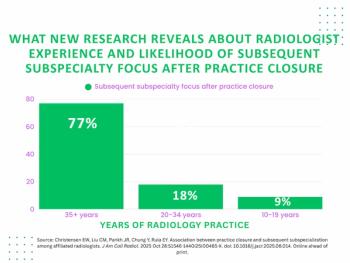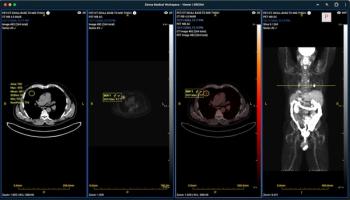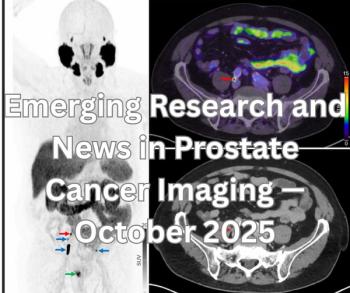For patients with metastatic castration-resistant prostate cancer (mCRPC), key findings on single-photon emission computed tomography/computed tomography (SPECT/CT) may offer significant prognostic information for gauging patient response to treatment with 177Lu-PSMA-617.
For the retrospective study, recently published in the Journal of Nuclear Medicine, researchers assessed the prognostic impact of total tumor volume (TTV) changes and new lesions (NLs) shown on SPECT/CT prior to second and third cycles of 177Lu-PSMA-617 (Pluvicto, Novartis) treatment in 66 patients with mCRPC. The median age of the cohort was 74 and the median prostate-specific antigen (PSA) level was 109 ng/mL). Thirty-six percent of the cohort (24 patients) passed away prior to analysis of the study results, according to the study authors.
The researchers noted that 20 percent of the cohort (13 patients) had NLs prior to starting the second cycle of 177Lu-PSMA-617 and 10 of those patients had increased TTV (including greater than 20 percent increases for seven patients). Prior to beginning treatment cycle three, 22 percent of the remaining patients (11 patients) had NLs and seven of these patients had increased TTV.
Multivariable analysis revealed that NLs shown on SPECT/CT prior to the second treatment cycle and the third treatment cycle were associated with 7.67 and 5.50 hazard ratios (HRs), respectively, for overall survival (OS). The researchers also found that TTV increases prior to the second treatment cycle were associated with a 2.37 HR for OS and TTV increases prior to the third cycle were associated with a 2.19 HR for OS.
“ … At this late stage of the disease, early predictors of response and progression are desired for a timely change in management given the relatively short survival of the patients. … This study found that, for a given PSA change relative to baseline, a higher absolute TTV and the appearance of NLs at the start of cycles 2 and 3 are independently associated with shorter OS,” wrote lead study author Ridvan Arda Demirci, M.D., who is affiliated with the Department of Radiology at the University of Washington in Seattle, and colleagues.
(Editor’s note: For additional content on prostate cancer imaging, click here.)
For the NLs seen on SPECT/CT prior to the second treatment cycle, the study authors noted that 46 percent were bone lesions, 23 percent were in the liver and 31 percent involved liver and bone lesions. Prior to the third treatment cycle, the researchers found that 55 percent of NLs were bone lesions and 36 percent were located in the liver.
Three Key Takeaways
- New lesions (NLs) and increased tumor volume as prognostic indicators. The study found that the presence of new lesions and increases in total tumor volume (TTV) observed on SPECT/CT before the second and third cycles of treatment with 177Lu-PSMA-617 were associated with shorter overall survival for patients with metastatic castration-resistant prostate cancer (mCRPC).
- Impact on treatment strategies. Patients with high TTV at the start of the second treatment cycle may require more aggressive or frequent treatment, while those with new disease that lacks PSMA expression might benefit from a combination of systemic and targeted therapies.
- Potential for personalized management. These findings suggest that SPECT/CT imaging could help guide personalized treatment plans for advanced prostate cancer with further research needed to validate these associations and refine treatment approaches.
While acknowledging the need for further research, the study authors maintained that the prognostic associations with TTV and NL findings on SPECT/CT could have a significant impact in the management of patients with advanced PCa.
“ … Patients with a higher volume of disease at the start of cycle 2 may require more intensive treatment, including a higher administered activity, more frequent dosing, or treatment with a-radiopharmaceutical therapy, whereas patients with development of new disease that has no or low PSMA expression may require combination therapy with other systemic treatments or targeted therapy to limited areas of disease,” posited Demirci and colleagues.
(Editor’s note: For related content, see “Can SPECT/CT Guidance Facilitate Personalized Dosing for Patients with Prostate Cancer?,” “Study Shows Discordance Between PSMA PET/CT and PSA Response in 47 Percent of Patients Treated for mCRPC” and “Phase 3 Study Shows Viability of 177Lu-PSMA-617 for Taxane-Naïve Metastatic Castration-Resistant Prostate Cancer.”)
Beyond the inherent limitations of a retrospective study, the authors acknowledged that treatment toxicity and challenges with radiopharmaceutical availability prevented standard six-week cycle durations of LuPSMA in some patients. The multivariable analysis did not include pre-treatment imaging findings or clinical factors, according to the study authors.































